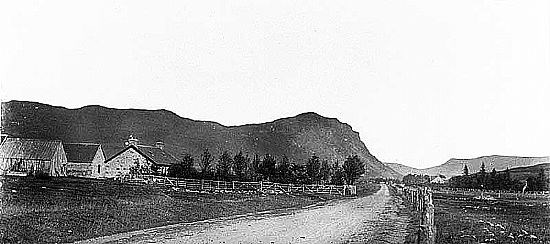Brin Rock from Croachy
By William Forbes, Farr
What is the difference between a strath and a glen? Well, in Strathnairn there isn't one. For as long as any native Strathnairners can remember, directions have always been given in terms of "up the glen" or "down the glen".
In this particular picture we are looking "down the glen" towards Brin Rock (in the distance) from West Croachy, home of the long and established Shaw family who still farm there today.
Barely visible - at the far end of the road - can be seen the Tighanallan Inn which is surrounded in trees at the foot of Brin Rock. This establishment later became the Flichity Inn until it's demise in the early 1960's when it was burnt to the ground. To many Strathnairners, the Flichity Inn was the "social hub" of the glen. To others, however, it was the "den of iniquity". It's burnt-out shell lay untouched until around 15 years later when the outbuildings were converted into holiday accommodation together with a licenced restaurant and was renamed the "Grouse and Trout Hotel".
On the hillside to the left of Brin Rock lies the ruins of an old croft and croft house called Shenval ("Seann Bhaile" - the old township) and can be seen clearly from the Grouse and Trout restaurant window. Shenval was the home of one notable Strathnairn character of the early and mid 20th Century. He was known locally as "Dai Thamhais" (David MacTavish). As well as being a crofter, Dai Thamhais was beadle in the Free Church of Scotland at Farr. One particular story is told of a drama that occurred during a church service one Sunday when a cat somehow managed to stray into the building while the minister was in full flow. Seeing it as his duty to shift the intruder, Dai promptly grabbed a brush to assist with the eviction of this particular gatecrasher. Much to the mirth of the irreverent, the horror of the reverent and total disbelief of the Reverend - the cat and the beadle became engrossed in one frantic battle of wills. The more Dai Thamhais tried to remove our feline friend, the more determined it became to stay inside the (relative) warmth and comfort of it's new-found home. The beadle became more and more frustrated as the cat sped furiously between the pews and around the feet of the faithful. As to who eventually won the battle between cat and beadle - perhaps we'll never know?
The hamlet of East Croachy can be seen in the middle distance to the right, beside the group of trees. The gable of St. Paul's Episcopalian Church can also be recognised. One particularly important personality of the 20th Century lived latterly in East Croachy. His name was Duncan MacBain (or "Dunc Carn Ban" as he was better known - named after the croft in Aberarder where he was raised). Duncan was the last native Gaelic speaker from Strathnairn and was a local historian with a wealth of knowledge about the area. As a roadman by profession, Duncan would have seen more of the Strath than most as he travelled up and down the Glen repairing damaged roads but also meeting and talking to people (in his usual friendly manner) as he went about his work. Up until 1976 (when Duncan's mother died), the only language spoken in the MacBain household was Gaelic. The quality and fluency of their Gaelic was particularly noted during a survey of native Gaelic speakers in the Inverness area in the 1950's. Duncan died in 1984 at the age of 76. With him went what had been the language of Strathnairn for well over a millennium. Prior to the introduction of the Gaelic language from Ireland, Strathnairners spoke the ancient Pictish tongue - a language which is still evidenced in local place names today (e.g Aberarder).
